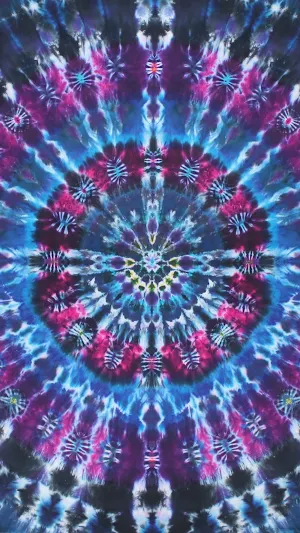







Tie-dye is the modern term used to describe a number of resist dyeing techniques and the resulting dyed products of these processes. The tie-dye process typically consists of folding, twisting, pleating, or crumpling fabric or a garment before binding with string or rubber bands, followed by applying dye or dyes. The manipulations of the material before the application of dye are called resists, as they partially or completely prevent the applied dye from coloring the fabric. More sophisticated tie-dye may involve additional steps, including an initial application of dye before the resist, multiple sequential dyeing and resist steps, and the use of other types of resists (stitching, stencils) and discharge.
Unlike traditional resist-dyeing techniques, modern tie-dye is characterized by the use of bright, saturated primary colors and bold patterns. These patterns, including the spiral, mandala, and peace sign, and the use of multiple bold colors, have become clichéd since the peak popularity of tie-dye in the United States in the 1960s and 1970s. The vast majority of tie-dye garments and objects produced for wholesale distribution use these designs, with many being mass-produced.
In the 21st century, a revived interest in more 'sophisticated' tie-dye techniques emerged in the fashion and hobby industry, characterized by simple motifs, monochromatic color schemes, a focus on fashionable garments and fabrics other than cotton, and the pursuit of tie-dye as an art form, rather than a commodity.
The earliest examples of tie-dye in the Far East are from Sui dynasty (5th century AD) China. The earliest surviving examples of pre-Columbian tie-dye in Peru date from 500 to 810 AD. Their designs include small circles and lines, with bright red, yellow, blue, and green colors.
Tie-dyeing was known in the US by 1909 when Professor Charles E. Pellow of Columbia University acquired some samples of tie-dyed muslin and subsequently gave a lecture and lived demonstration of the technique.
Please choose your desired tie-dye wallpaper and set it as a lock screen or home screen to give your phone an outstanding appearance.
We are grateful for your great support and always welcome your feedback about our wallpapers.
Samsung is a South Korean company founded in 1938 by Lee Byung-Chul....
Devil, a spiritual entity believed to encourage people to do evil in...
Grim Reaper is seen in Judaism as both the angel of death...
Latin "Carnivora": meaning "meat-eaters." But actually, the carnivorous diet is not the...
Between 1960 and 1975, customizers created a new vehicle concept, developing GM...
Sloths are medium-sized mammals living in Central and South America, comprising six...
Created with AppPage.net
Similar Apps - visible in preview.